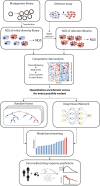Emerging strategies to bridge the gap between pharmacogenomic research and its clinical implementation
- PMID: 32194983
- PMCID: PMC7057970
- DOI: 10.1038/s41525-020-0119-2
Emerging strategies to bridge the gap between pharmacogenomic research and its clinical implementation
Abstract
The genomic inter-individual heterogeneity remains a significant challenge for both clinical decision-making and the design of clinical trials. Although next-generation sequencing (NGS) is increasingly implemented in drug development and clinical trials, translation of the obtained genomic information into actionable clinical advice lags behind. Major reasons are the paucity of sufficiently powered trials that can quantify the added value of pharmacogenetic testing, and the considerable pharmacogenetic complexity with millions of rare variants with unclear functional consequences. The resulting uncertainty is reflected in inconsistencies of pharmacogenomic drug labels in Europe and the United States. In this review, we discuss how the knowledge gap for bridging pharmacogenomics into the clinics can be reduced. First, emerging methods that allow the high-throughput experimental characterization of pharmacogenomic variants combined with novel computational tools hold promise to improve the accuracy of drug response predictions. Second, tapping of large biobanks of therapeutic drug monitoring data allows to conduct high-powered retrospective studies that can validate the clinical importance of genetic variants, which are currently incompletely characterized. Combined, we are confident that these methods will improve the accuracy of drug response predictions and will narrow the gap between variant identification and its utilization for clinical decision-support.
Keywords: Genetic markers; Predictive markers.
© The Author(s) 2020.
Conflict of interest statement
Competing interestsV.M.L. and M.I.-S. are co-founders and shareholders of HepaPredict AB.
Figures



Similar articles
-
Pharmacogenomics in the era of next generation sequencing - from byte to bedside.Drug Metab Rev. 2021 May;53(2):253-278. doi: 10.1080/03602532.2021.1909613. Epub 2021 May 17. Drug Metab Rev. 2021. PMID: 33820459 Review.
-
Translating pharmacogenomic sequencing data into drug response predictions-How to interpret variants of unknown significance.Br J Clin Pharmacol. 2025 Feb;91(2):252-263. doi: 10.1111/bcp.15915. Epub 2023 Oct 16. Br J Clin Pharmacol. 2025. PMID: 37759374 Free PMC article. Review.
-
Computational Tools to Assess the Functional Consequences of Rare and Noncoding Pharmacogenetic Variability.Clin Pharmacol Ther. 2021 Sep;110(3):626-636. doi: 10.1002/cpt.2289. Epub 2021 Jun 10. Clin Pharmacol Ther. 2021. PMID: 33998671 Review.
-
Next-generation sequencing in pharmacogenomics - fit for clinical decision support?Expert Rev Clin Pharmacol. 2024 Mar;17(3):213-223. doi: 10.1080/17512433.2024.2307418. Epub 2024 Jan 23. Expert Rev Clin Pharmacol. 2024. PMID: 38247431 Review.
-
Pharmacogenetic and pharmacogenomic discovery strategies.Cancer Drug Resist. 2019 Jun 19;2(2):225-241. doi: 10.20517/cdr.2018.008. eCollection 2019. Cancer Drug Resist. 2019. PMID: 35582724 Free PMC article. Review.
Cited by
-
A Review of the Important Role of CYP2D6 in Pharmacogenomics.Genes (Basel). 2020 Oct 30;11(11):1295. doi: 10.3390/genes11111295. Genes (Basel). 2020. PMID: 33143137 Free PMC article. Review.
-
Genetic ancestry in population pharmacogenomics unravels distinct geographical patterns related to drug toxicity.iScience. 2024 Sep 10;27(10):110916. doi: 10.1016/j.isci.2024.110916. eCollection 2024 Oct 18. iScience. 2024. PMID: 39391720 Free PMC article.
-
Inverting the model of genomics data sharing with the NHGRI Genomic Data Science Analysis, Visualization, and Informatics Lab-space.Cell Genom. 2022 Jan 12;2(1):100085. doi: 10.1016/j.xgen.2021.100085. Epub 2022 Jan 13. Cell Genom. 2022. PMID: 35199087 Free PMC article.
-
Emerging trends in pharmacogenomics: from common variant associations toward comprehensive genomic profiling.Hum Genomics. 2023 Nov 24;17(1):105. doi: 10.1186/s40246-023-00554-9. Hum Genomics. 2023. PMID: 37996916 Free PMC article. No abstract available.
-
From pharmacogenetics to pharmaco-omics: Milestones and future directions.HGG Adv. 2022 Mar 16;3(2):100100. doi: 10.1016/j.xhgg.2022.100100. eCollection 2022 Apr 14. HGG Adv. 2022. PMID: 35373152 Free PMC article. Review.
References
Publication types
LinkOut - more resources
Full Text Sources
Miscellaneous

